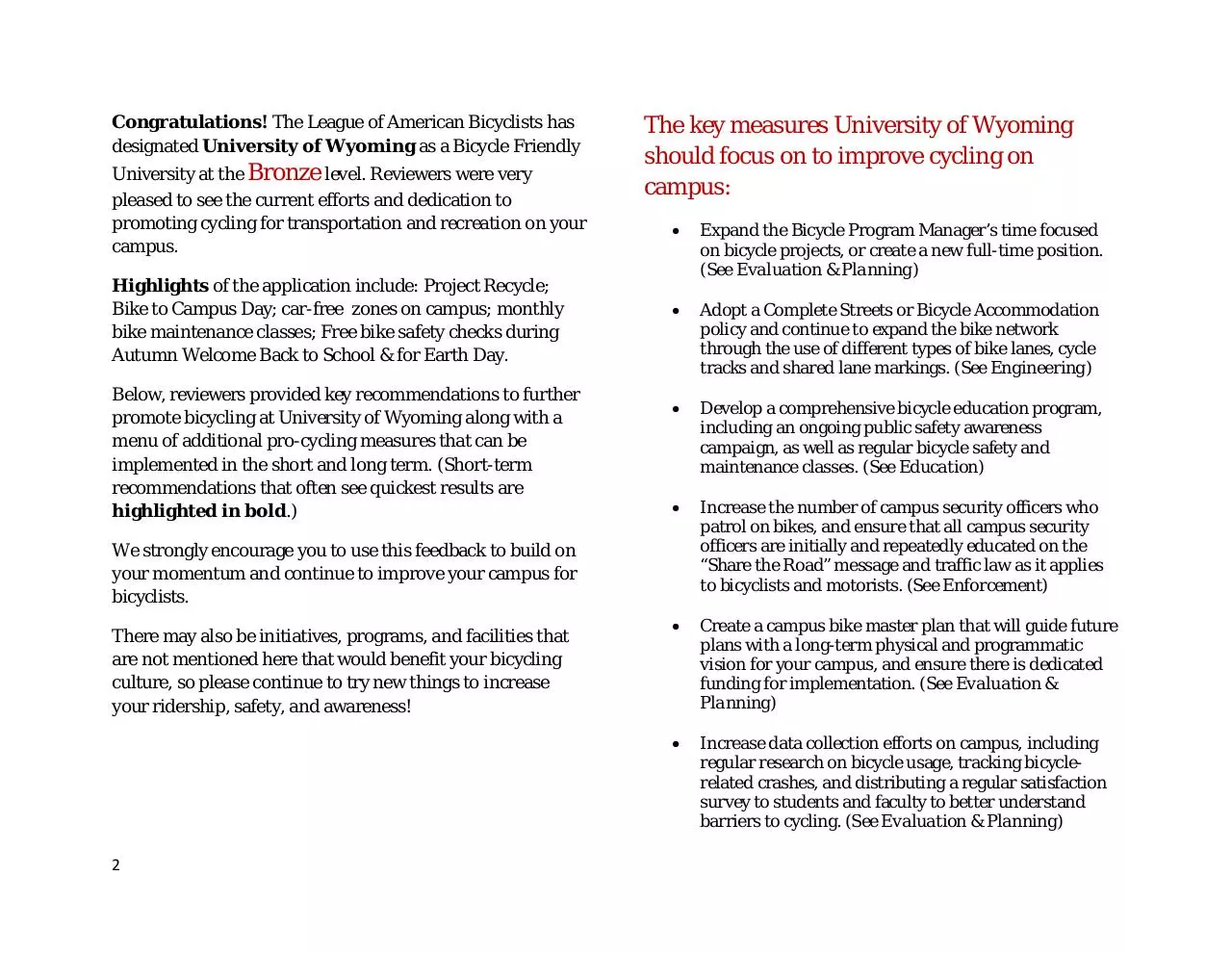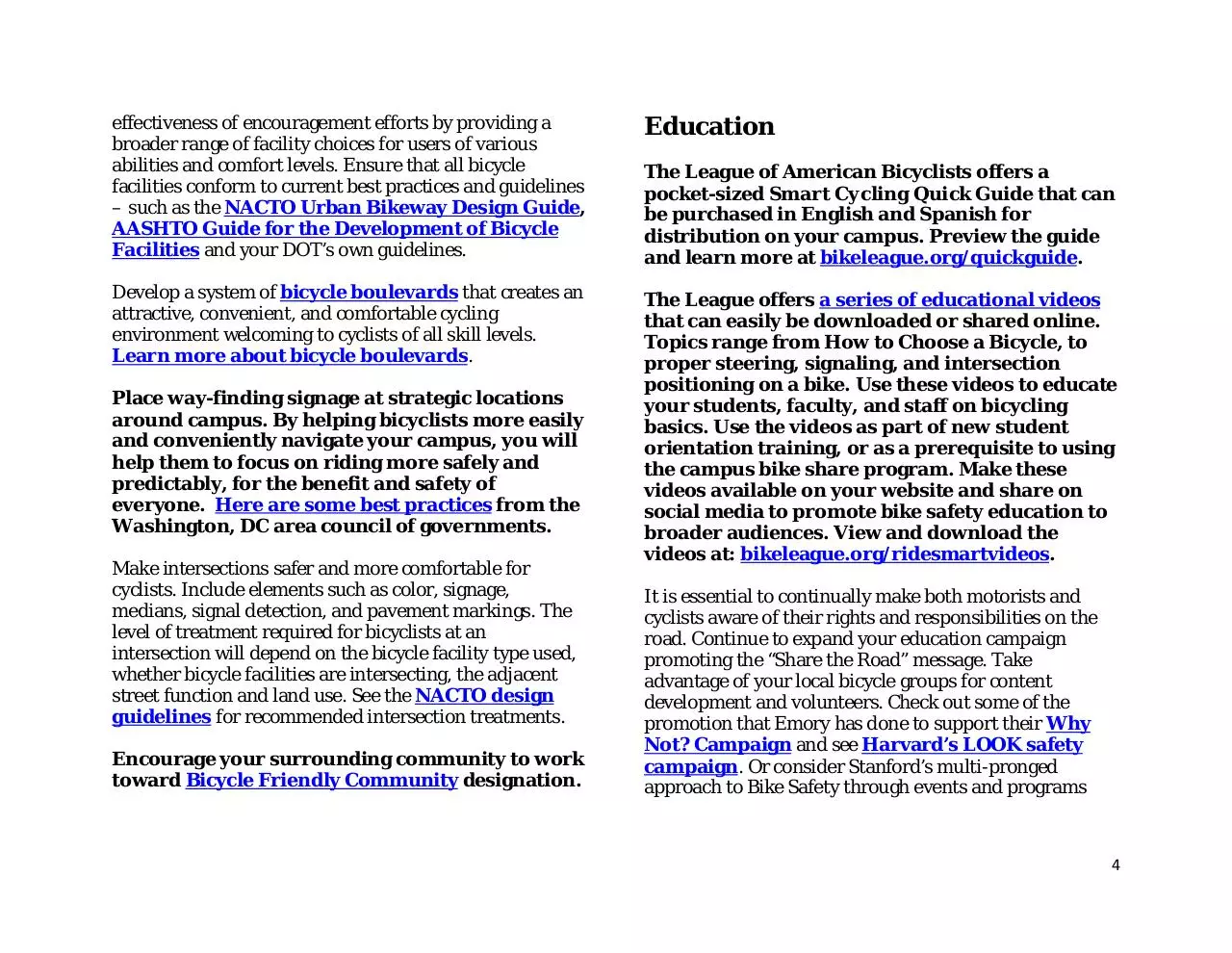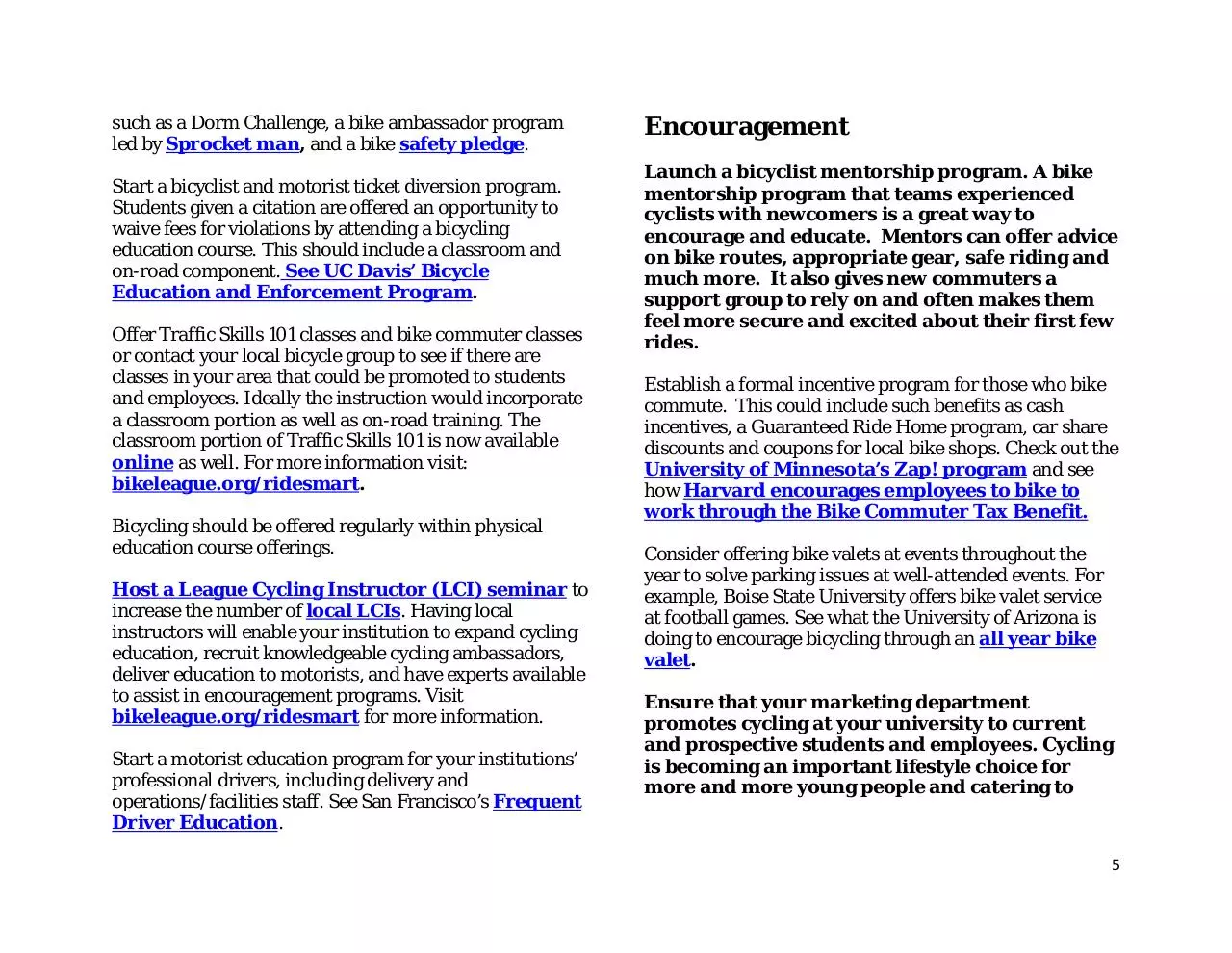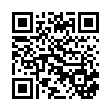BFU 2015 feedback University of Wyoming (PDF)
File information
Author: Nicole
This PDF 1.5 document has been generated by Acrobat PDFMaker 10.1 for Word / Adobe PDF Library 10.0, and has been sent on pdf-archive.com on 22/04/2016 at 20:25, from IP address 129.72.x.x.
The current document download page has been viewed 559 times.
File size: 286.14 KB (8 pages).
Privacy: public file





File preview
BFU
BICYCLE FRIENDLY UNIVERSITY
FEEDBACK REPORT
2015
UNIVERSITY OF WYOMING
1
Congratulations! The League of American Bicyclists has
designated University of Wyoming as a Bicycle Friendly
University at the Bronze level. Reviewers were very
pleased to see the current efforts and dedication to
promoting cycling for transportation and recreation on your
campus.
Highlights of the application include: Project Recycle;
Bike to Campus Day; car-free zones on campus; monthly
bike maintenance classes; Free bike safety checks during
Autumn Welcome Back to School & for Earth Day.
Below, reviewers provided key recommendations to further
promote bicycling at University of Wyoming along with a
menu of additional pro-cycling measures that can be
implemented in the short and long term. (Short-term
recommendations that often see quickest results are
highlighted in bold.)
The key measures University of Wyoming
should focus on to improve cycling on
campus:
•
Expand the Bicycle Program Manager’s time focused
on bicycle projects, or create a new full-time position.
(See Evaluation & Planning)
•
Adopt a Complete Streets or Bicycle Accommodation
policy and continue to expand the bike network
through the use of different types of bike lanes, cycle
tracks and shared lane markings. (See Engineering)
•
Develop a comprehensive bicycle education program,
including an ongoing public safety awareness
campaign, as well as regular bicycle safety and
maintenance classes. (See Education)
•
Increase the number of campus security officers who
patrol on bikes, and ensure that all campus security
officers are initially and repeatedly educated on the
“Share the Road” message and traffic law as it applies
to bicyclists and motorists. (See Enforcement)
•
Create a campus bike master plan that will guide future
plans with a long-term physical and programmatic
vision for your campus, and ensure there is dedicated
funding for implementation. (See Evaluation &
Planning)
•
Increase data collection efforts on campus, including
regular research on bicycle usage, tracking bicyclerelated crashes, and distributing a regular satisfaction
survey to students and faculty to better understand
barriers to cycling. (See Evaluation & Planning)
We strongly encourage you to use this feedback to build on
your momentum and continue to improve your campus for
bicyclists.
There may also be initiatives, programs, and facilities that
are not mentioned here that would benefit your bicycling
culture, so please continue to try new things to increase
your ridership, safety, and awareness!
2
Menu of additional recommendations to
further promote bicycling:
Engineering
Adopt an official Complete Streets or Bicycle
Accommodation policy and offer implementation
guidance. By adopting a Complete Streets policy,
institutions direct their transportation planners and
engineers to routinely design and operate the entire right
of way to enable safe access for all users, regardless of
age, ability, or mode of transportation. This means that
every transportation project will make the street network
better and safer for drivers, transit users, pedestrians,
and bicyclists – making your campus a better place to
live, work and study.
Provide ongoing training opportunities for
engineering and planning staff related to
accommodating bicyclists. Consider providing
APBP memberships for one or more related staff.
Ensure that there are easily-accessible end-of-trip
facilities for all bicyclists commuting to your campus.
Consider a policy requiring showers and locker rooms in
all non-residential buildings. One of the most common
excuses people use to not commute by bike is that they
don’t have a shower at their destination. Also make sure
to provide showers and lockers as a benefit not as an
additional cost to off-campus students and employees.
Ensure that the standards for all bike parking
conform to the Association of Pedestrian and
Bicycle Profressionals (APBP) bike parking
guidelines.
Consider constructing a bike station to provide centrallylocated, secure and covered parking for cyclists. Like the
Bike Center at the University of Minnesota, a bike
station can serve as a hub for commuters providing repair
services, shower and locker facilities, and bike route, and
event information. Check out other areas that have
already implemented similar facilities.
Allow students who live on campus to store their
bikes in their dorm rooms. See Northwest
University’s Campus Life policies relating to
bicycle storage in campus housing.
Accommodate bicyclists during construction by
providing suitable detour routes and signage.
All transit vehicles such as campus shuttles
should accommodate bicycles with bike racks or
with access on the vehicle. See this report on
integrating bicycling and transit.
Continue to expand the bike network and to increase
network connectivity through the use of different types of
bike lanes, cycle tracks and shared lane arrows.
On-street improvements coupled with the expansion of
the off-street system will encourage more people to
cycle and will improve safety. Ensure smooth transitions
for bicyclists between the trail network and the street
network. These improvements will also increase the
3
effectiveness of encouragement efforts by providing a
broader range of facility choices for users of various
abilities and comfort levels. Ensure that all bicycle
facilities conform to current best practices and guidelines
– such as the NACTO Urban Bikeway Design Guide,
AASHTO Guide for the Development of Bicycle
Facilities and your DOT’s own guidelines.
Education
Develop a system of bicycle boulevards that creates an
attractive, convenient, and comfortable cycling
environment welcoming to cyclists of all skill levels.
Learn more about bicycle boulevards.
The League offers a series of educational videos
that can easily be downloaded or shared online.
Topics range from How to Choose a Bicycle, to
proper steering, signaling, and intersection
positioning on a bike. Use these videos to educate
your students, faculty, and staff on bicycling
basics. Use the videos as part of new student
orientation training, or as a prerequisite to using
the campus bike share program. Make these
videos available on your website and share on
social media to promote bike safety education to
broader audiences. View and download the
videos at: bikeleague.org/ridesmartvideos.
Place way-finding signage at strategic locations
around campus. By helping bicyclists more easily
and conveniently navigate your campus, you will
help them to focus on riding more safely and
predictably, for the benefit and safety of
everyone. Here are some best practices from the
Washington, DC area council of governments.
Make intersections safer and more comfortable for
cyclists. Include elements such as color, signage,
medians, signal detection, and pavement markings. The
level of treatment required for bicyclists at an
intersection will depend on the bicycle facility type used,
whether bicycle facilities are intersecting, the adjacent
street function and land use. See the NACTO design
guidelines for recommended intersection treatments.
Encourage your surrounding community to work
toward Bicycle Friendly Community designation.
The League of American Bicyclists offers a
pocket-sized Smart Cycling Quick Guide that can
be purchased in English and Spanish for
distribution on your campus. Preview the guide
and learn more at bikeleague.org/quickguide.
It is essential to continually make both motorists and
cyclists aware of their rights and responsibilities on the
road. Continue to expand your education campaign
promoting the “Share the Road” message. Take
advantage of your local bicycle groups for content
development and volunteers. Check out some of the
promotion that Emory has done to support their Why
Not? Campaign and see Harvard’s LOOK safety
campaign. Or consider Stanford’s multi-pronged
approach to Bike Safety through events and programs
4
such as a Dorm Challenge, a bike ambassador program
led by Sprocket man, and a bike safety pledge.
Start a bicyclist and motorist ticket diversion program.
Students given a citation are offered an opportunity to
waive fees for violations by attending a bicycling
education course. This should include a classroom and
on-road component. See UC Davis’ Bicycle
Education and Enforcement Program.
Offer Traffic Skills 101 classes and bike commuter classes
or contact your local bicycle group to see if there are
classes in your area that could be promoted to students
and employees. Ideally the instruction would incorporate
a classroom portion as well as on-road training. The
classroom portion of Traffic Skills 101 is now available
online as well. For more information visit:
bikeleague.org/ridesmart.
Bicycling should be offered regularly within physical
education course offerings.
Host a League Cycling Instructor (LCI) seminar to
increase the number of local LCIs. Having local
instructors will enable your institution to expand cycling
education, recruit knowledgeable cycling ambassadors,
deliver education to motorists, and have experts available
to assist in encouragement programs. Visit
bikeleague.org/ridesmart for more information.
Start a motorist education program for your institutions’
professional drivers, including delivery and
operations/facilities staff. See San Francisco’s Frequent
Driver Education.
Encouragement
Launch a bicyclist mentorship program. A bike
mentorship program that teams experienced
cyclists with newcomers is a great way to
encourage and educate. Mentors can offer advice
on bike routes, appropriate gear, safe riding and
much more. It also gives new commuters a
support group to rely on and often makes them
feel more secure and excited about their first few
rides.
Establish a formal incentive program for those who bike
commute. This could include such benefits as cash
incentives, a Guaranteed Ride Home program, car share
discounts and coupons for local bike shops. Check out the
University of Minnesota’s Zap! program and see
how Harvard encourages employees to bike to
work through the Bike Commuter Tax Benefit.
Consider offering bike valets at events throughout the
year to solve parking issues at well-attended events. For
example, Boise State University offers bike valet service
at football games. See what the University of Arizona is
doing to encourage bicycling through an all year bike
valet.
Ensure that your marketing department
promotes cycling at your university to current
and prospective students and employees. Cycling
is becoming an important lifestyle choice for
more and more young people and catering to
5
these interests will improve your institution’s
competitiveness.
Recreational bicycling can be promoted through nearby
bicycle amenities such as a mountain bike park, a
cyclocross course or a pump track. If such facilities exist,
partner with local organizations to promote these
resources to students.
Enforcement
Increase the number of Public Safety officers that
patrol streets on bikes, as it gives officers a better
understanding of the conditions for cyclists. Also
ensure that secluded off road paths are regularly
patrolled to improve personal safety and
encourage more people to take advantage of this
amenity.
Ensure that all Public Safety officers are initially and
repeatedly educated on the “Share the Road” message
and traffic law as it applies to bicyclists and motorists.
Training is offered by the International Police Mountain
Bike Association, the Law Enforcement Bicycle
Association and the National Highway Traffic Safety
Administration. Here are some recommended Law
Enforcement Products: Bicycle Safety seminar; Law
Enforcement's Roll Call Video: “Enforcing Law for
Bicyclists”; and Enhancing Bicycle Safety: Law
Enforcement’s Role (CD-ROM Training).
Have Public Safety officers distribute helmets (or
coupons to a local bike shop) to encourage all types of
cyclists to ride more safely and to remove the barriers to
attaining this essential bike accessory. See the helmet
promotions at Stanford.
Ask police officers to target both motorist and
cyclist infractions to ensure that laws are being
followed by all road users. Ensure that
bicycle/car crashes are investigated thoroughly
and that citations are given fairly.
Enforcement practices could also include positive
enforcement ticketing. Officers and student
bicycling ambassadors could team up with local
stores to reward safe cycling practices by handing
out gift certificates to cyclists who are “caught”
following the law.
Pass additional campus laws or ordinances that protect
cyclists, e.g. implement specific penalties for motorists
for failing to yield to a cyclist when turning, make it
illegal to park or drive in a bike lane (intersections
excepted), implement penalties for motor vehicle users
that ‘door’ cyclists, and specifically protect all vulnerable
road users.
Evaluation & Planning
Expand the bike program on your campus. See what
other universities are doing and what resources are
available for higher ed institutions:
universitybikeprograms.org.
6
Expand the Bicycle Program Manager’s time focused on
bicycle projects, or create a new full-time position. This
staff person should spend more time working closely with
the Bicycle Advisory Committee, reviewing
development proposals to ensure that bicycle
requirements are incorporated and to assess bicycling
impacts, developing and implementing educational and
promotional programs, writing grant proposals, serving
as the contact for bicycling inquiries and complaints,
educating other staff about state and federal facilities
standards and guidelines, and coordinating with
neighboring communities, transit agencies and other
departments to implement policies and projects. See
this report on the importance of Bicycle &
Pedestrian program staff.
Create a campus bike master plan that will guide
future plans with a long-term physical and programmatic
vision for your campus. Complement infrastructure
planning such as parking and network connectivity with
encouragement, education, and enforcement programs to
increase ridership and safety. Develop a clear vision
statement and set ambitious but attainable targets. The
overarching goal should be to increase the percentage of
trips made by bicycle on campus. Check out
University of California Berkeley’s plan as an
example.
Ensure that there is dedicated funding for the
implementation of the bicycle master plan, as well as
ongoing bicycle infrastructure and programming needs.
Dedicating a portion of automobile parking fees toward
non-automobile facilities and services is a great way to
establish a baseline annual budget for bicycle
improvements. You can also reach outside the university
for grants and private funding for specific projects.
Regularly conduct research on bicycle usage to more
efficiently distribute resources according to demand.
Conduct yearly counts using automated and manual
counters in partnership with advocacy organizations.
Consider participating in the National Bicycle and
Pedestrian Documentation Project.
Install automatic bicycle counters on your campus to
better gauge ridership on an ongoing basis. Look into
tools such as the EcoCounter for automatic electronic
counters, or online services like the National Bike
Challenge for self-reporting data collection. See how
the University of Minnesota uses the Zap! Program to
track and reward ridership on their campus.
Develop a reporting system to track bicycle,
bicycle/pedestrian, and bicycle/automobile crashes to
help identify conflict points that may need special
attention.
Expand efforts to evaluate crash statistics to produce a
specific plan to reduce the number of crashes on campus.
Available tools include Intersection Magic and
PBCAT. See the report Bicyclist Fatalities and
Serious Injuries in New York City 1996-2005.
Distribute a satisfaction survey to students and
faculty. Analyze responses to assess barriers, and direct
resources according to demand and the needs of the
commuter.
7
Benefits of Further Improving
University of Wyoming for Cycling
Consider conducting an economic impact study on
bicycling within your college/ university.
For more ideas and best practices please visit the
Bicycle Friendly University Resource Page.
Please also see the attached document for additional
comments and feedback from bicyclists on your campus.
Increasing bicycle use can improve the environment by reducing the
impact on the community of pollution and noise, limiting greenhouse
gases, and improving the quality of public spaces; Reduce
congestion by shifting short trips (the majority of trips in cities) out of
cars. This will also make campuses more accessible for public
transport, walking, essential car travel, and emergency services; Save
lives by creating safer conditions for bicyclists and as a direct
consequence improve the safety of all other road users. Research
shows that increasing the number of bicyclists on the street improves
bicycle safety; Increase opportunities for students, faculty and staff
to participate socially and economically in campus and community
activities, regardless of income or ability.
Greater choice of travel modes also increases independence; Boost
the economy by creating a campus environment and community that
is an attractive destination for new students, residents, tourists and
businesses; Enhance recreational opportunities and further
contribute to the quality of life on campus; Save university funds by
increasing the efficient use of public space, reducing the need for
costly new road infrastructure, preventing crashes, improving the
health of the campus community, and increasing the use of public
transport; Enhance campus safety and security by increasing the
number of “eyes on the street” and providing more options for
movement in the event of emergencies, natural disasters, and major
campus events; Improve the health and well being of the campus
population by promoting routine physical activity.
8
Download BFU 2015 feedback University of Wyoming
BFU_2015_feedback_University of Wyoming.pdf (PDF, 286.14 KB)
Download PDF
Share this file on social networks
Link to this page
Permanent link
Use the permanent link to the download page to share your document on Facebook, Twitter, LinkedIn, or directly with a contact by e-Mail, Messenger, Whatsapp, Line..
Short link
Use the short link to share your document on Twitter or by text message (SMS)
HTML Code
Copy the following HTML code to share your document on a Website or Blog
QR Code to this page

This file has been shared publicly by a user of PDF Archive.
Document ID: 0000364412.